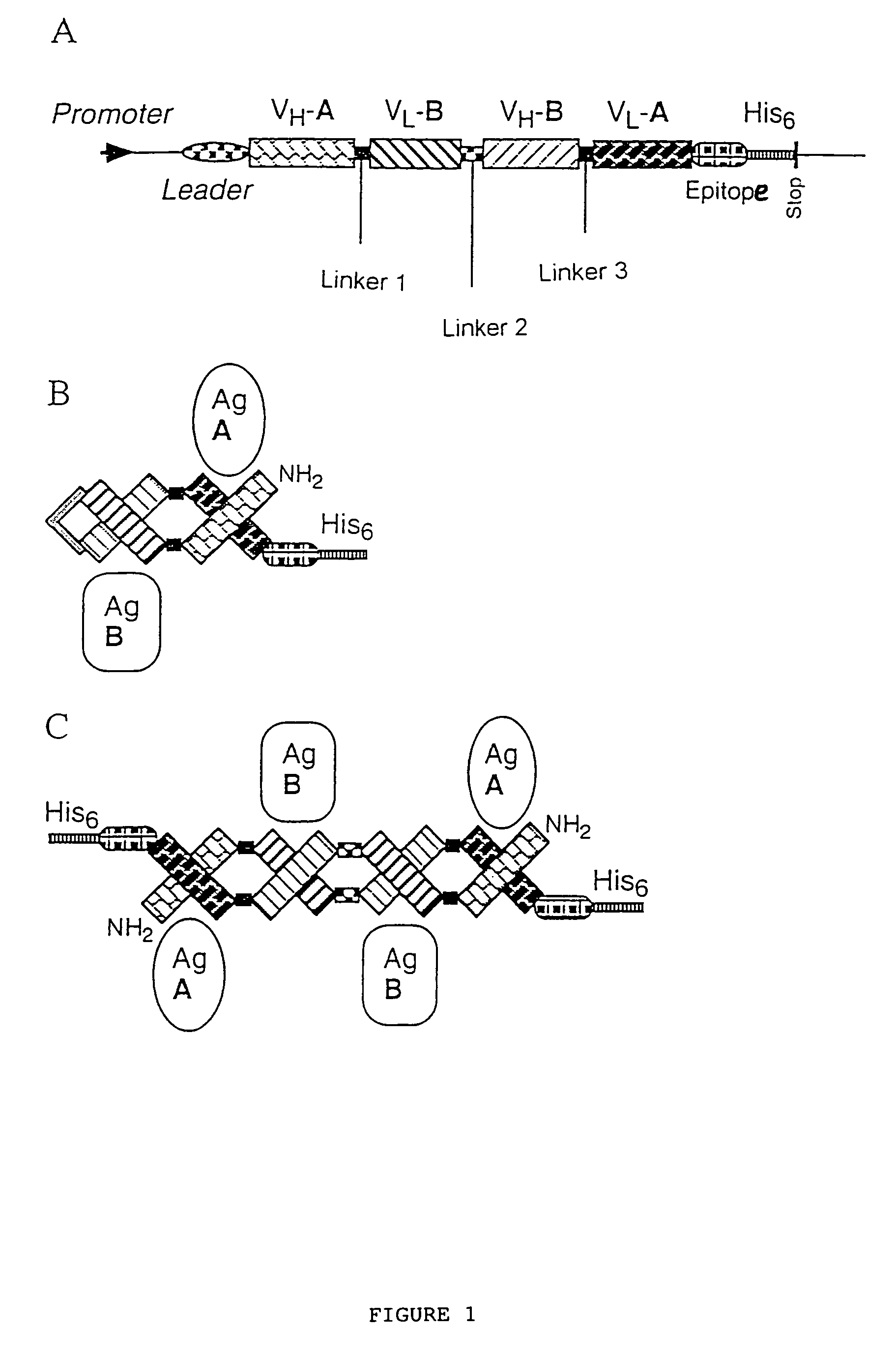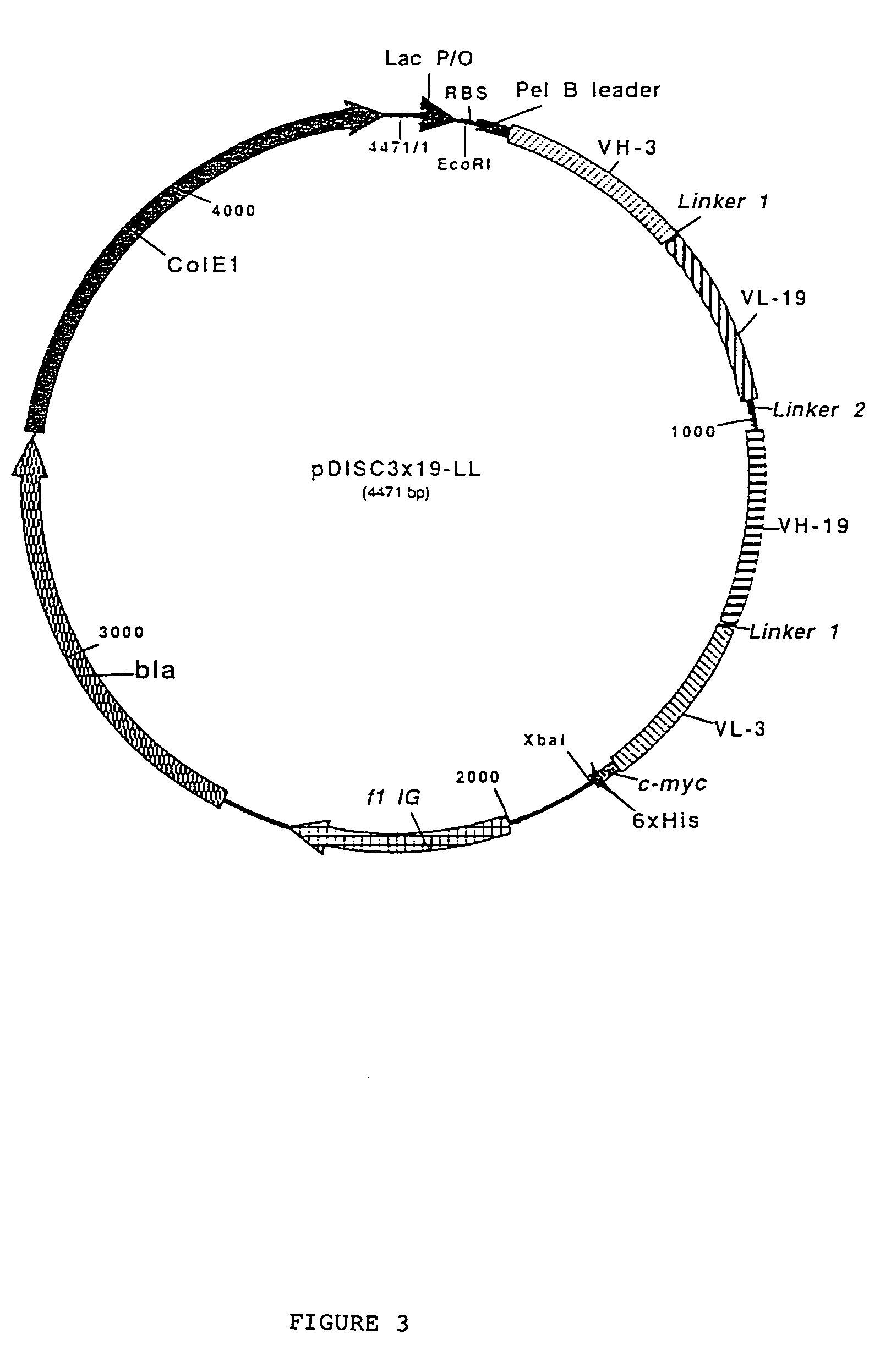Multivalent antibody constructs
a multi-purpose, antibody technology, applied in the field of multi-purpose fv antibody constructs, can solve the problems of limited usability of f/sub>v/sub>antibody constructs and only little stability
- Summary
- Abstract
- Description
- Claims
- Application Information
AI Technical Summary
Problems solved by technology
Method used
Image
Examples
example 1
A. Example 1
Construction of the Plasmids Pdisc3x19-ll and Pdisc3x9-sl for the Expression of Bivalent, Bispecific And / or Tetravalent, Bispecific Fv Antibody Constructs in Bacteria
[0036]The plasmids pHOG-αCD19 and pHOG-dmOKT3 which code for the scFv fragments derived from the hybridoma HD37 which is specific to human CD19 (Kipriyanov et al., 1996, J.-Immunol. Meth. 196:51–62) and from the hybridoma OKT3 which is specific to human CD3 (Kipriyanov et al., 1997, Protein Eng. 10:445–453), respectively, were used for the construction of expression plasmids for a single-chain Fv antibody construct. A PCR fragment 1 of the VH domain of anti-CD 19, followed by a segment which codes for a GlyGly linker, was produced using the primers DP1, 5′-TCACACAGAATTC-TTAGATCTATTAAAGAGGAGAAATTAACC (SEQ ID NO:1) and DP2, 5′-AGCACACGATATCACCGCCAAGCTTGGGTGTTGTTTTGGC (SEQ ID NO:2) (FIG. 2). The PCR fragment 1 was cleaved by EcoRI and EcoRV and ligated with the EcoRI / EcoRV-linearized plasmid pHOG-dmOKT3 so as t...
example 2
B. Example 2
Construction of the Plasmids Ppic-disc-ll and Ppic-disc-sl for the Expression of Bivalent, Bispecific And / or Tetravalent, Bispecific Fv Antibody Constructs in Yeast
[0037](A) Construction of pPIC-DISC-SL
[0038]The vector pPICZαA (Invitrogen BV, Leek, Netherlands) for the expression and secretion of recombinant proteins in the yeast Pichia pastoris was used as a starting material. It contains a gene which codes for the Saccharomyces cerevisiae α-factor secretion signal, followed by a polylinker. The secretion of this vector is based on the dominant selectable marker, Zeocin™ which is bifunctional in both Pichia and E. coli. The gene which codes for the tetravalent Fv antibody construct (scDia-SL) was amplified by means of PCR by the template pDIC3x19-SL using the primers 5-PIC, 5′-CCGTGAATTCCAGGTGCAACTGCAGCAGTCTGGGGCTGAACTGGC, and pSEXBn (SEQ ID NO:8). 5′-GGTCGACGTTAACCGACAAACAACAGATAAAACG (SEQ ID NO:9). The resulting PCR product was cleaved by EcoRI and XbaI and ligated in...
example 3
C. Example 3
Expression of the Tetravalent And / or Bivalent Fv Antibody Construct in Bacteria
[0041]E. coli XL1-blue cells (Strategene, La Jolla, Calif.) which had been transformed with the expression plasmids pDISC3x19-L1 and pDISC3x19-SL, respectively, were cultured overnight in 2xYT medium with 50 μg / ml ampicillin and 100 mM glucose (2xYTGa) at 37° C. 1:50 dilutions of the overnight cultures in 2xYTGA were cultured as flask cultures at 37° C. while shaking with 200 rpm. When the cultures had reached an OD600 value of 0.8, the bacteria were pelleted by 10-minute centrifugation with 1500 g at 20° C. and resuspended in the same volume of a fresh 2xYT medium containing 50 λg ampicillin and 0.4 M saccharose. IPTG was added up to a final concentration of 0.1 mM, and the growth was continued at room temperature (20–22° C.) for 18–20 h. The cells were harvested by 10-minute centrifugation with 5000 g at 4° C. The culture supernatant was held back and stored on ice. In order to isolate the s...
PUM
 Login to View More
Login to View More Abstract
Description
Claims
Application Information
 Login to View More
Login to View More - R&D
- Intellectual Property
- Life Sciences
- Materials
- Tech Scout
- Unparalleled Data Quality
- Higher Quality Content
- 60% Fewer Hallucinations
Browse by: Latest US Patents, China's latest patents, Technical Efficacy Thesaurus, Application Domain, Technology Topic, Popular Technical Reports.
© 2025 PatSnap. All rights reserved.Legal|Privacy policy|Modern Slavery Act Transparency Statement|Sitemap|About US| Contact US: help@patsnap.com



